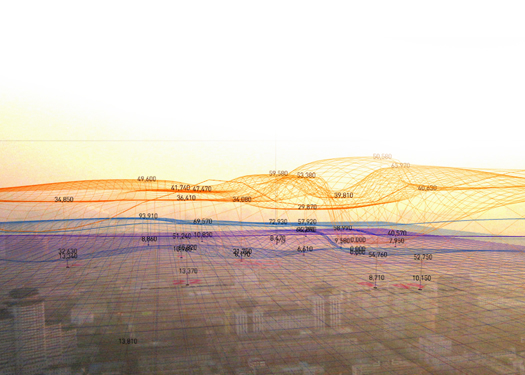
[Nerea Calvillo’s “In the Air” — “a visualization project which aims to make visible the microscopic and invisible agents of Madrid´s air” — Visualizar ’08]
A brief interruption to the flood-blogging (which will resume shortly, with more on 1927 and crevasses) to note that I’ll be speaking in Madrid at Visualizar ’11 “Understanding Infrastructures”. The opening seminar, which runs from June 14-15, promises to be fantastic, featuring talks from Amber Frid-Jimenez, Dietmar Offenhuber, Drew Hemment, Tom Raftery, and Usman Haque on a wide range of topics related to the visualization of infrastructures: the “smart grid”; the politics and crafting of data; innovation in the development and deployment of infrastructures; and “the internet of obsolete objects”, as well as an array of selected papers. The aim of the gathering as a whole — discussing and prototyping ways to reveal and interpret the operation of infrastructures — is similarly excellent, and if past editions of Visualizar are any guide, the workshop which follows the seminar is sure to produce worthwhile projects.
The program for Visualizar ’11 begins by quoting James Burke from Connections:
“More and more of technology infiltrates every aspect of our lives. It’s become a life support system without which we can’t survive. And yet, how much of it do we understand? Do I bother myself with the reality of what happens when I get into a big steel box, press a button, and rise into the sky? Of course I don’t. I take going up the world like that for granted, we all do. And as the years of the 20th century have gone by the things we take for granted have multiplied way beyond the ability of any individual to understand in a lifetime. The things around us, the man-made inventions we’ve provided ourselves with, are like a vast network, each part of which is interdependent with all the others. (…) All the things in that network has become so specialized that only the people involved in making them understand them.“
It continues with the contemporary example of the smartphone:
Let’s have a look at any object around us. For it to reach our hands, it has been necessary to exploit natural resources, submit it to complex manufacturing processes, distribute it through worldwide supply networks and validate it through international agreements and regulations of all kind. A big amount of our everyday acts -turn on the light, open a tap or take out the garbage- are not isolated events, but form part of a major system, altough we often ignore its scale and rarely have the chance to observe it as a whole. When we use a last generation smartphone in the middle of the street to look for the address of a restaurant, we are not only using the plastic and metal piece that we have in our hands but also activating a vast network that covers thousand of kilometres, formed by satellites in orbit, antennas set up in roofs and data centres that store information in anonymous locations.
Infrastractures are the support system of global society. Physical infrastructures (electric networks, pipelines, reservoirs) but also information (radio broadcasting, underwater cables) transport (sea routes, aerial routes) as well as legal and financial infrastructures that rule international trade and markets, as well as the hidden but active infrastractures that control the networks of drugs distribution or illegal immigration.
If we could contemplate the superposition of all of these infrastructures we could obtain an approximate representation of how a contemporary society works. Nevertheless, as citizens, we are often only conscious of those elements we are related with. Our field of action is determined by the rules that determine how these systems operate, and their functional limits How could we be conscious of them in order to understand them better?
This is a project that mammoth has long been interested in; my talk, “An Atlas of iPhone Landscapes”, begins with the subject matter of a post from last year, “a preliminary atlas of gizmo landscapes”, but will spiral outward from “the spatial trace and organizational logic of patterns of reception, broadcast, transmission, dissemination, production, and extraction” to encompass an array of wider concerns, from the role of the invisibility of infrastructural landscapes in the infrastructural public policy problem to re-industrialization to “the new aesthetic” of “cheap satellite imagery”.
I would, of course, love to meet any mammoth readers who are or will be in Madrid; the seminar is at MediaLab Prado and is, to the best of my knowledge, free and open to the public.


Hi,
I am Mammoth reader (and a participant in a previous Medialab Prado seminar). I would love to be in Madrid these days but I have a trip to Alicante these days.
What a pity! Do they stream it?
Best,
Paula
Too bad! But I do think they plan to stream it through the MediaLab site.
It certainly is free and open to the public and all the takes will be streamed live.
Great :)!